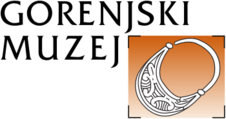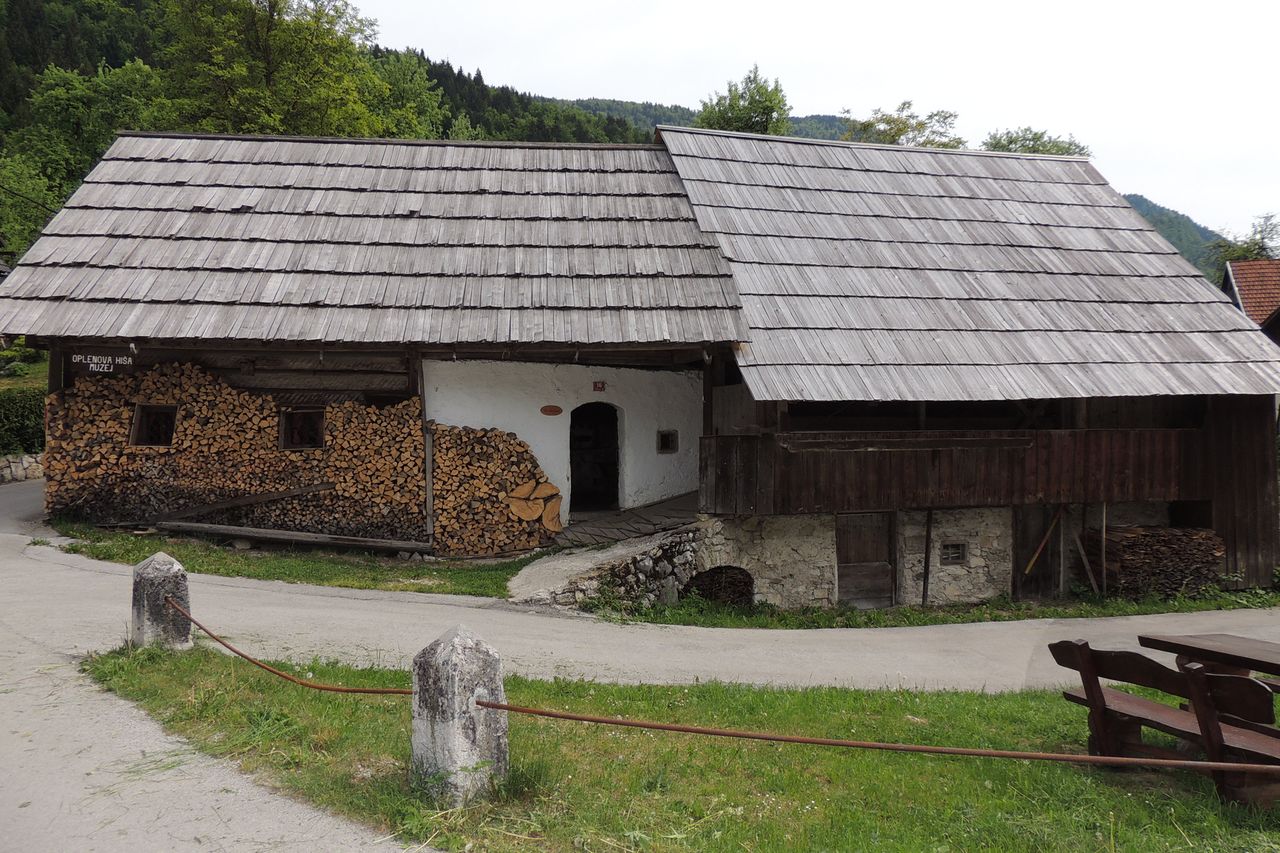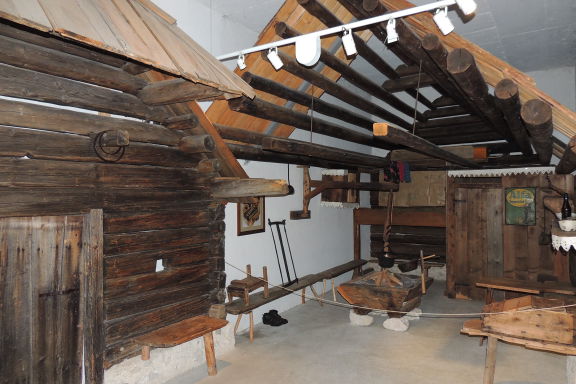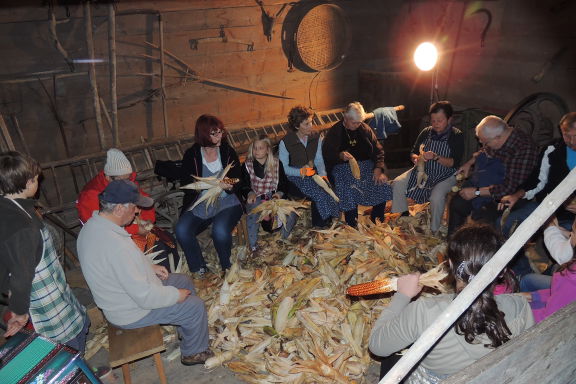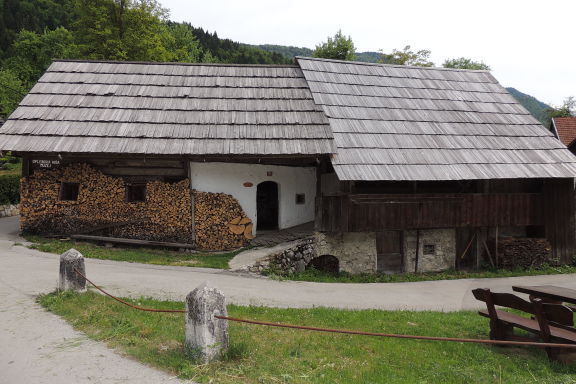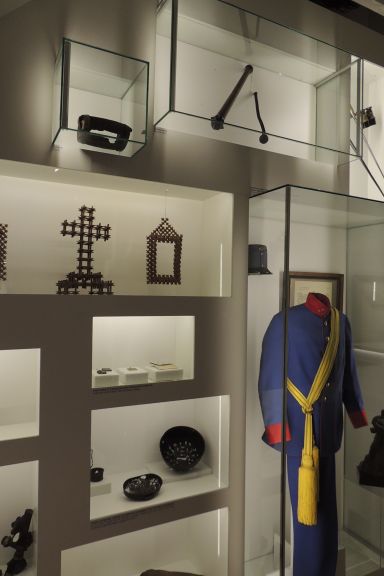Difference between revisions of "Gorenjska Museum"
Janez Premk (talk | contribs) |
(mwtool_article) |
||
| (47 intermediate revisions by 7 users not shown) | |||
| Line 1: | Line 1: | ||
{{Article | {{Article | ||
| status = TOPROOFREAD NIFERTIK! | | status = TOPROOFREAD NIFERTIK! | ||
| − | | maintainer = | + | | maintainer = Admin |
}} | }} | ||
{{Infobox | {{Infobox | ||
| − | | name = Gorenjska Museum | + | | name = Gorenjska Museum |
| localname = Gorenjski muzej | | localname = Gorenjski muzej | ||
| − | | street = | + | | logo = Gorenjska Museum (logo).svg |
| + | | street = Tomšičeva 42 | ||
| town = SI-4000 Kranj | | town = SI-4000 Kranj | ||
| + | | map = http://www.openstreetmap.org/?lon=14.35983&lat=46.23314&zoom=15&layer=mapnik | ||
| telephone = 386 (0) 4 201 3950 | | telephone = 386 (0) 4 201 3950 | ||
| fax = 386 (0) 4 201 3951 | | fax = 386 (0) 4 201 3951 | ||
| email = info@gorenjski-muzej.si | | email = info@gorenjski-muzej.si | ||
| website = http://www.gorenjski-muzej.si | | website = http://www.gorenjski-muzej.si | ||
| − | | | + | | founded by = Municipality of Kranj |
| − | | opening hours = 7am–15pm Mon–Fri | + | | opening hours = 7am–15pm Mon–Fri |
| contacts = {{Contact | | contacts = {{Contact | ||
| − | | name = | + | | name = Marjana Žibert |
| role = Director | | role = Director | ||
| telephone = 386 (0) 4 201 3956 | | telephone = 386 (0) 4 201 3956 | ||
| − | | email = | + | | email = marjana.zibert@gorenjski-muzej.si |
}}{{Contact | }}{{Contact | ||
| − | | name = | + | | name = |
| − | | role = | + | | role = |
| − | | telephone = | + | | telephone = |
| − | | email = | + | | email = |
}}{{Contact | }}{{Contact | ||
| name = Jelena Justin | | name = Jelena Justin | ||
| Line 30: | Line 32: | ||
| email = jelena.justin@gorenjski-muzej.si | | email = jelena.justin@gorenjski-muzej.si | ||
}} | }} | ||
| + | | accounts = | ||
| + | http://www.facebook.com/gorenjski.muzej.kranj | ||
| + | https://www.instagram.com/gorenjskimuzejgm/ | ||
}} | }} | ||
{{Teaser| | {{Teaser| | ||
| − | [[ | + | Founded in [[established::1953]], the [[Gorenjska Museum]] in Kranj collects, houses, researches, and represents the movable cultural heritage of the wider Gorenjska (Upper Carniola) region. The main permanent exhibition ''Beautiful Gorenjska'' is located at the [[Khislstein Castle]] in the centre of Kranj, the museum, however, manages also several sites in Kranj and smaller museums in the region. |
| + | |||
}} | }} | ||
| − | == | + | == Background== |
| − | The idea of establishing a museum in Kranj was born before | + | The idea of establishing a museum in Kranj was born before World War I. In 1953 the Municipal Museum of Kranj was founded and had its seat in [[Prešeren House]], the former residence of Slovene poet [[France Prešeren]]. In 1957 a second museum was established in Kranj: the Gorenjska Regional Museum, which was renamed to the Museum of the People's Revolution in 1961. The Gorenjska Museum was established in 1963 by the merging of the Municipal Museum of Kranj and the Kranj Museum of the People's Revolution. The following locations in Kranj were assigned to the new museum: Town Hall on Glavni trg (Main Square), [[Prešeren House]], and a Baroque Palace on the street Tavčarjeva ulica. In 1993 the Baroque Palace was returned to its original owners. The Gorenjska Museum acquired new spaces in the [[Khislstein Castle]], where its headquarters, administrative and service spaces were located until 2008, when the museum moved to a new location on Savska cesta, Kranj. Today the castle accommodates the museum's main permanent exhibition. |
| − | == Programme | + | == Programme and mission == |
| − | The | + | The mission of the Gorenjska Museum has been built on the basis of fundamental collections, such as the archaeological and ethnological collections of folk art and ancient, cultural and modern art history, as well as modernity, a Cabinet of Slovene Photography, the creative art of Gorenjska and "Prešereniana" – the study of the work and life of France Prešeren. The museum's collections and work are presented through exhibitions, publications, workshops, study circles, and lectures. |
| − | From the outset Gorenjska Museum has taken a keen interest in contemporary art and events in Gorenjska, which are continuously reflected in its gallery activities | + | From the outset Gorenjska Museum has taken a keen interest in contemporary art and events in Gorenjska, which are continuously reflected in its gallery activities. The museum is also an active publisher, especially of the cycle ''Gorenjski kraji in ljudje'' [Places and People of Gorenjska]. |
| − | The museum | + | The museum's library is a valuable research facility for many in-house and external scholars and interested parties, as it covers all the areas of the museum. |
== Branches == | == Branches == | ||
| − | Today in addition to Prešeren House | + | Today in addition to the [[Prešeren House]] the Gorenjska Museum also oversees the [[Kranj Town Hall]], [[Khislstein Castle]], [[Kranj Archaeological Site]], the [[Museum of Alpine Dairy Farming, Stara Fužina]], [[Oplen House]], and the [[Tomaž Godec Museum]]. All the major museum branches are represented in the museum, along with a series of auxiliary services (a restoration and conservation workshop, historical archives, a photo-laboratory, a picture library, and a library). |
| + | |||
| + | There are numerous permanent and temporary exhibitions related mainly to Gorenjska region topics, held in the above locations. | ||
| + | |||
| + | {{image|Oplen House 2015.jpg}} | ||
| − | == | + | == Departments and collections == |
| − | There are multiple collections in the main and branch units of the museum, divided and arranged according to the policy of each museum department | + | There are multiple collections in the main and branch units of the museum, divided and arranged according to the policy of each museum department. The Ethnological Department's notable collections include those of embroidery, wraps, and horse hair sieves. The Ancient History Department contains artefacts dating from the 18th, 19th, and the beginning of the 20th centuries. The Recent History Department collects and maintains materials on political, military and economy, mainly of the WW2 period, while the Contemporary History Department focuses more on the end of the 20th and the beginning of the 21st century. There is also the Archaeological Department which participates in numerous digs in the region and has organised the permanent exhibition ''The Iron Thread'' in the [[Kranj Town Hall]]. |
| − | + | The Art History Department's collection encompasses numerous sculptures and paintings by masters of the 15th through the 18th centuries, as well as works by [[Leopold Layer]] (1752–1828) and his contemporaries, and the realists of the 19th Century. The collection of Slovenian Modern Art is also extensive and includes works by Gorenjska artists and by the recipients of the [[Prešeren Award and Prešeren Foundation Awards|Prešeren Award]]. The museum keeps also the Cabinet of Slovenian Photography, the oldest public collection of photographs in Slovenia (since 1970). There is also the Cultural History Department, which focuses primarily on the [[Prešeren House]] and the burgher life in Kranj. | |
| − | + | In addition, after the completion of excavations at the Kranj Parish Church an archaeological monument was arranged in which the visible remnants of the late Roman octagonal baptistery. Remnants of the late 13th century baptistery and other finds are visible. | |
| − | |||
| − | |||
| − | + | ==Projects== | |
| + | The Gorenjska Museum participates in the ''Iron Route'', an Interreg III B project for the Alpine area, which connects different and remote Alpine lands through a common history of mining and iron manufacturing. The 15-year-long archaeological research in the East Julian Alps was conducted in collaboration with the [[Triglav National Park]] and the [[Institute of Archaeology]] of the [[Scientific Research Centre (ZRC SAZU), Slovene Academy of Science and Arts]]. ''Iron Route'' reveals the early settlements in the high-mountains from the bronze age to the early middle ages. The ''in situ'' display panels were installed on five different trails above 1,500 metres altitude. The discoveries are presented also in a temporary exhibition in the Gorenjska Museum. | ||
| + | |||
| + | == Awards == | ||
| + | The museum's long-standing (1965–1972) director [[Cene Avguštin]] (1923–2010), the first museologist of the Gorenjska region, won the [[Stele Award]] in 1999 for his lifetime achievements. | ||
== See also == | == See also == | ||
| − | + | In Kranj | |
| − | * [[ | + | * [[Khislstein Castle]] |
| − | |||
* [[Kranj Town Hall]] | * [[Kranj Town Hall]] | ||
| − | |||
| − | |||
* [[Prešeren House]] | * [[Prešeren House]] | ||
| + | * [[Kranj Archaeological Site]] | ||
| + | In the Bohinj area | ||
* [[Tomaž Godec Museum]] | * [[Tomaž Godec Museum]] | ||
| − | * [[ | + | * [[Museum of Alpine Dairy Farming, Stara Fužina]] |
| + | * [[Oplen House]] | ||
| + | |||
== External links == | == External links == | ||
| − | * [http://www.gorenjski-muzej.si Gorenjska Museum | + | * [http://www.gorenjski-muzej.si Gorenjska Museum website] |
| + | |||
| + | {{gallery}} | ||
[[Category:Museums]] | [[Category:Museums]] | ||
| + | [[Category:Regional museums]] | ||
| + | [[Category:Publishers]] | ||
| + | [[Category:Museum publishers]] | ||
| + | [[Category:Museum libraries]] | ||
| + | [[Category:Libraries]] | ||
| + | [[Category:Archives]] | ||
| + | [[Category:Venues]] | ||
| + | |||
| + | [[Category:Visual arts museums]] | ||
| + | [[Category:Municipal cultural institutions]] | ||
| + | [[Category:Archives & Libraries]] | ||
| + | [[Category:Cultural_heritage_education_and_research]] | ||
Latest revision as of 01:20, 19 February 2021
Background
The idea of establishing a museum in Kranj was born before World War I. In 1953 the Municipal Museum of Kranj was founded and had its seat in Prešeren House, the former residence of Slovene poet France Prešeren. In 1957 a second museum was established in Kranj: the Gorenjska Regional Museum, which was renamed to the Museum of the People's Revolution in 1961. The Gorenjska Museum was established in 1963 by the merging of the Municipal Museum of Kranj and the Kranj Museum of the People's Revolution. The following locations in Kranj were assigned to the new museum: Town Hall on Glavni trg (Main Square), Prešeren House, and a Baroque Palace on the street Tavčarjeva ulica. In 1993 the Baroque Palace was returned to its original owners. The Gorenjska Museum acquired new spaces in the Khislstein Castle, where its headquarters, administrative and service spaces were located until 2008, when the museum moved to a new location on Savska cesta, Kranj. Today the castle accommodates the museum's main permanent exhibition.
Programme and mission
The mission of the Gorenjska Museum has been built on the basis of fundamental collections, such as the archaeological and ethnological collections of folk art and ancient, cultural and modern art history, as well as modernity, a Cabinet of Slovene Photography, the creative art of Gorenjska and "Prešereniana" – the study of the work and life of France Prešeren. The museum's collections and work are presented through exhibitions, publications, workshops, study circles, and lectures.
From the outset Gorenjska Museum has taken a keen interest in contemporary art and events in Gorenjska, which are continuously reflected in its gallery activities. The museum is also an active publisher, especially of the cycle Gorenjski kraji in ljudje [Places and People of Gorenjska].
The museum's library is a valuable research facility for many in-house and external scholars and interested parties, as it covers all the areas of the museum.
Branches
Today in addition to the Prešeren House the Gorenjska Museum also oversees the Kranj Town Hall, Khislstein Castle, Kranj Archaeological Site, the Museum of Alpine Dairy Farming, Stara Fužina, Oplen House, and the Tomaž Godec Museum. All the major museum branches are represented in the museum, along with a series of auxiliary services (a restoration and conservation workshop, historical archives, a photo-laboratory, a picture library, and a library).
There are numerous permanent and temporary exhibitions related mainly to Gorenjska region topics, held in the above locations.
Departments and collections
There are multiple collections in the main and branch units of the museum, divided and arranged according to the policy of each museum department. The Ethnological Department's notable collections include those of embroidery, wraps, and horse hair sieves. The Ancient History Department contains artefacts dating from the 18th, 19th, and the beginning of the 20th centuries. The Recent History Department collects and maintains materials on political, military and economy, mainly of the WW2 period, while the Contemporary History Department focuses more on the end of the 20th and the beginning of the 21st century. There is also the Archaeological Department which participates in numerous digs in the region and has organised the permanent exhibition The Iron Thread in the Kranj Town Hall.
The Art History Department's collection encompasses numerous sculptures and paintings by masters of the 15th through the 18th centuries, as well as works by Leopold Layer (1752–1828) and his contemporaries, and the realists of the 19th Century. The collection of Slovenian Modern Art is also extensive and includes works by Gorenjska artists and by the recipients of the Prešeren Award. The museum keeps also the Cabinet of Slovenian Photography, the oldest public collection of photographs in Slovenia (since 1970). There is also the Cultural History Department, which focuses primarily on the Prešeren House and the burgher life in Kranj.
In addition, after the completion of excavations at the Kranj Parish Church an archaeological monument was arranged in which the visible remnants of the late Roman octagonal baptistery. Remnants of the late 13th century baptistery and other finds are visible.
Projects
The Gorenjska Museum participates in the Iron Route, an Interreg III B project for the Alpine area, which connects different and remote Alpine lands through a common history of mining and iron manufacturing. The 15-year-long archaeological research in the East Julian Alps was conducted in collaboration with the Triglav National Park and the Institute of Archaeology of the Scientific Research Centre (ZRC SAZU), Slovene Academy of Science and Arts. Iron Route reveals the early settlements in the high-mountains from the bronze age to the early middle ages. The in situ display panels were installed on five different trails above 1,500 metres altitude. The discoveries are presented also in a temporary exhibition in the Gorenjska Museum.
Awards
The museum's long-standing (1965–1972) director Cene Avguštin (1923–2010), the first museologist of the Gorenjska region, won the Stele Award in 1999 for his lifetime achievements.
See also
In Kranj
In the Bohinj area



